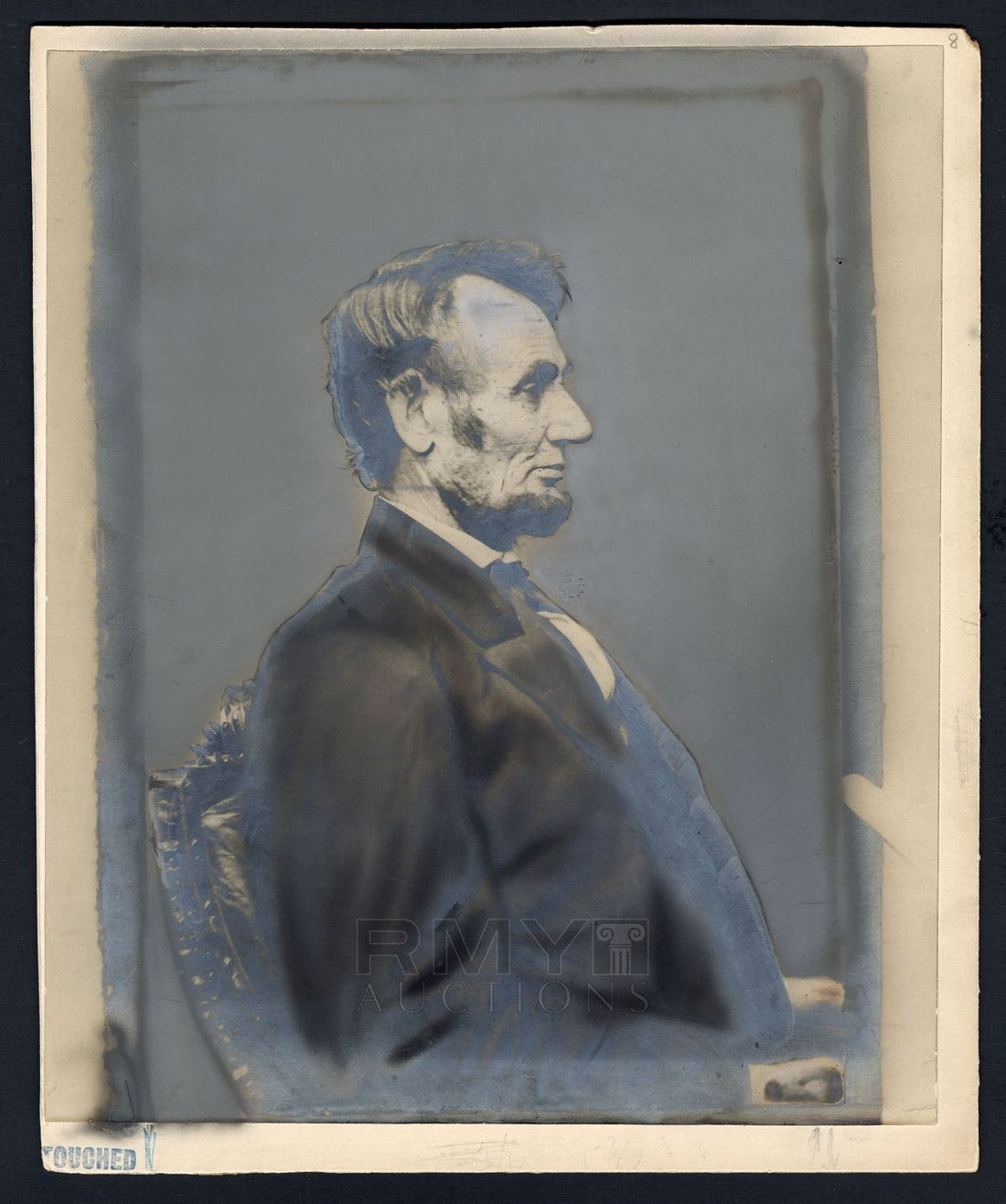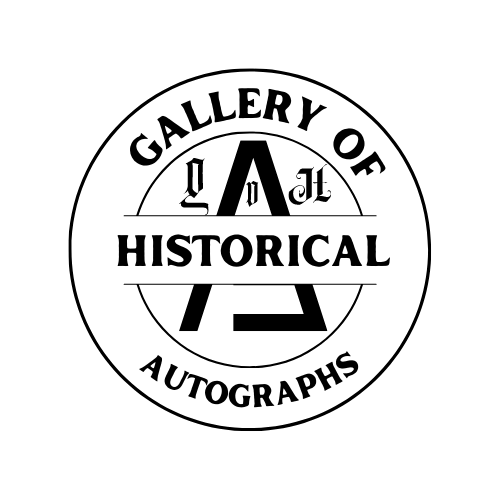
Lincoln’s “Penny Pose” by Brady in Rare Oversize Format: A Rare Frederick H. Meserve Treasure
Share

Few images of Abraham Lincoln are as instantly recognizable—or as historically significant—as the portrait commonly called the “penny pose.” Best known for its later use on the U.S. one-cent coin, this iconic profile of Lincoln was originally captured by legendary photographer Mathew Brady. Now, an exceedingly rare oversized version—bearing a distinctive inscription from collector Frederick H. Meserve—has come to light, underscoring both the enduring power of Brady’s artistry and the depth of Meserve’s influence in preserving America’s photographic history.
Mathew Brady and Lincoln: A Moment in Time
Renowned for his Civil War images and landmark portraits of American statesmen, Mathew Brady had photographed Lincoln on multiple occasions. One famous session, often dated to February 9, 1864, produced several profiles and three-quarter views that have been credited with helping shape the modern image of the 16th president. Though Brady’s bustling Washington, D.C., studio was known for capturing high-profile portraits, Lincoln’s solemn visage and weary eyes—reflecting the weight of the ongoing Civil War—made these particular photos stand out.
On the day of this session, Lincoln was preparing for a heated campaign season, seeking re-election amidst a deeply divided nation. Brady’s skillful lighting and compositional flair helped produce an indelible image—one that would later inspire artist Victor David Brenner’s 1909 design for the Lincoln cent, introduced in honor of the president’s 100th birthday.
From Portrait to Pocket: The Production of the Penny
To commemorate the 100th anniversary of Lincoln’s birth in 1909, the U.S. Mint sought a new design for the one-cent coin. Sculptor Victor David Brenner, who had already created a bas-relief of Lincoln, used Brady’s famous photograph—particularly Lincoln’s left-facing profile—as his primary reference.
-
Debut and Controversy: The new penny was officially released on August 2, 1909, making it the first U.S. coin to depict a real historical figure. Public excitement was immense, but controversy soon followed when critics objected to Brenner’s initials—“V.D.B.”—featured prominently on the reverse. After public outcry, the Mint removed the initials, only to reintroduce them in smaller form on Lincoln’s shoulder in subsequent mintings.
-
Lasting Legacy: In its first year, millions of these “Lincoln pennies” were struck at the Philadelphia and San Francisco Mints. Over a century later, the basic profile design remains on the penny, ensuring that Brady’s original 1864 portrait continues to circulate in pockets across America—often without people realizing its Civil War-era origins.
The “Penny Pose” and the Making of an Icon
By the early 20th century, Lincoln’s image had already achieved near-mythic status. When the U.S. Mint commissioned a new penny to celebrate Lincoln’s centennial, Brenner’s adaptation of Brady’s photograph resonated with the public’s admiration for the martyred president. The distinctive tilt of Lincoln’s head and his unmistakable profile transformed a once-private studio session into an enduring national symbol.
Frederick H. Meserve: Guardian of Lincoln’s Photographic Legacy
Frederick Hill Meserve (1865–1962) was one of the most prominent collectors of Lincolniana and Civil War-era photography. Known for amassing a vast collection of original negatives and prints—many from Brady’s own studio—Meserve played a crucial role in cataloging and preserving the visual record of the Civil War and Lincoln’s presidency. His passion, sparked by searching for images of his father’s Civil War service, became a lifelong mission, and he meticulously documented each photograph he acquired or printed.

In many instances, Meserve had access to glass negatives that he personally printed, ensuring exceptional image clarity and quality. The oversized print you see here, signed on the back by Meserve, stands as a prime example of his dedication and skill—a piece that may represent a unique or extremely limited run from an original Brady negative.
A Stunning Oversize Portrait—The Rarest Format
While smaller carte de visite (CDV) prints or cabinet cards of the “penny pose” occasionally appear in auctions and private collections, an oversized version is extraordinarily scarce. We have not encountered another example of this size, which suggests that Meserve may have made only a few such large-format prints—or perhaps even just this single copy.

That rarity is underscored by recent auction results. Heritage Auctions sold a CDV print of the same Brady photograph for $8,125.00—a testament to the high regard for Lincoln images, especially those from Brady’s studio. An oversize Meserve print, therefore, represents the pinnacle of collectability for Lincoln aficionados and Civil War photography devotees.
The Day the Image Was Made: Lincoln in 1864
When Lincoln sat for Mathew Brady in 1864, the Civil War still raged, though major Union victories were on the horizon. These photographic sessions had dual purposes: they were both political—providing images for campaign materials—and personal, as Lincoln understood the powerful role photographs played in shaping public perception. Brady, for his part, recognized that every pose of Lincoln was an essential piece of American history and took great care to ensure these portraits would resonate through the ages.
Why This Piece Matters
- Historic Icon: This is the definitive portrait that inspired the Lincoln cent design, an image deeply woven into American cultural identity.
- Meserve Provenance: Frederick H. Meserve’s distinctive stamp and signature verify the authenticity and importance of this print.
- Extremely Rare Format: Oversized prints of the “penny pose” are nearly unknown, elevating this example to museum-level significance.
- Collector’s Treasure: Given that even CDV-sized prints command high prices, an oversize Meserve print is a potential crown jewel for any serious Lincoln or Civil War photography collection.
Recent News: Trump Announces Halt to Penny Production

President Donald Trump announced that he has instructed the Treasury Department to halt the production of new pennies in an effort to “rip the waste out of our great nation’s budget.” Via posts on his Truth Social platform, the 78-year-old president cited the high cost of minting each penny at more than 2 cents per coin. He directed Treasury Secretary Scott Bessent to stop further penny production, pointing to ongoing taxpayer losses—reported by Elon Musk’s temporary Department of Government Efficiency as exceeding $179 million in the 2023 fiscal year alone.
Industry Reactions and Legal Questions:
- The Associated Press noted that in 2024, the U.S. produced 3.2 billion pennies, costing about 3.69 cents each to make.
- Stopping the production outright may require an act of Congress, though some economists believe the Treasury Secretary could simply decline to mint new pennies.
- This would not be the first time a North American government has retired its smallest unit; the Royal Canadian Mint stopped distributing Canadian pennies in 2012.
Whether this initiative succeeds could mark a turning point for the historic coin that traces its iconic profile back to Mathew Brady’s 1864 photograph of Lincoln. While the penny once served as a tangible link to the 16th president’s legacy, any official move to discontinue it would almost certainly ignite fresh debates among collectors, budget hawks, and everyday Americans.
Have questions or thoughts about Lincoln’s “penny pose,” Frederick Meserve’s collection, or the legacy of the penny itself? Leave a comment below and join the conversation!
Update:
This unique piece was sold by RR Auctions on April 10, 2025 for $2,063.


